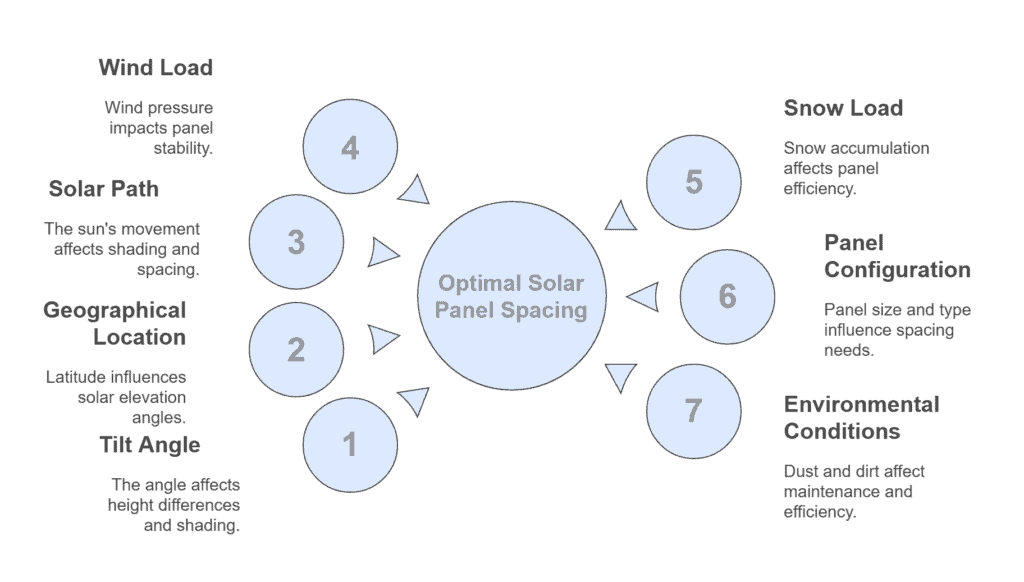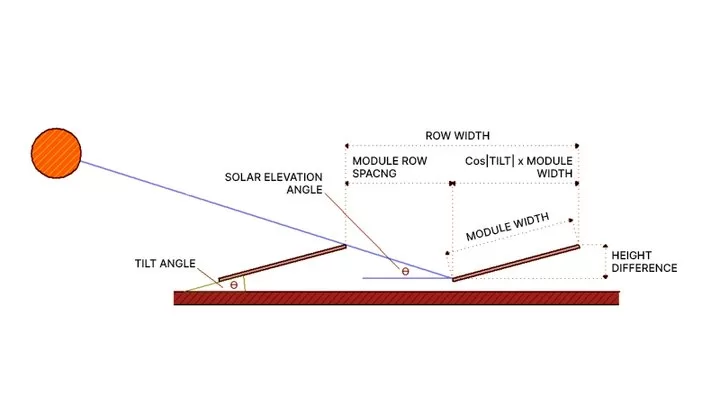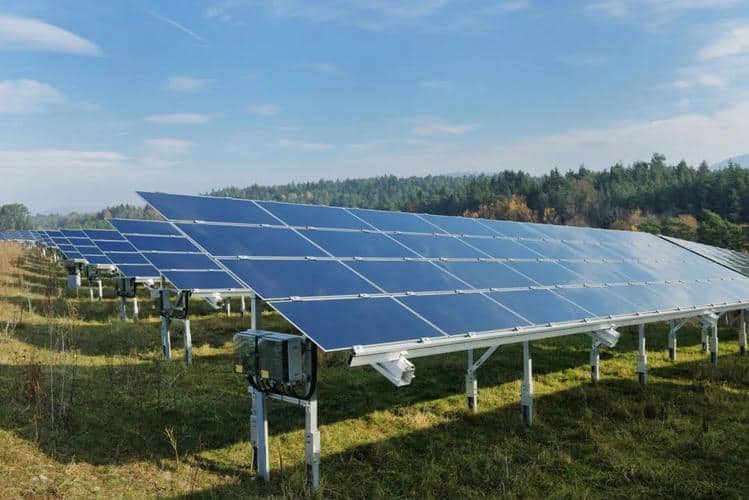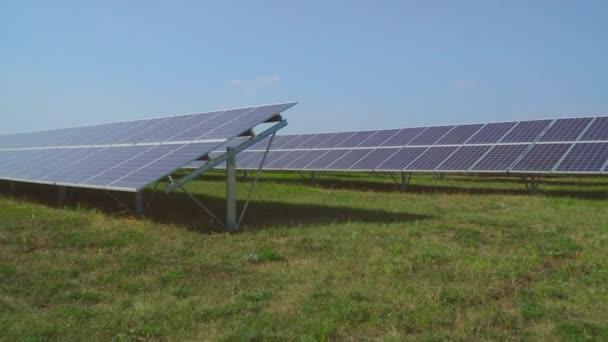When designing a solar power system, one of the most overlooked but critical aspects is the distance between solar panels. While it may seem like a minor detail, proper panel spacing can have a profound impact on system efficiency and long-term performance. Too little space can lead to shading, reducing sunlight exposure and significantly lowering energy output. On the other hand, excessive spacing can waste valuable space and increase costs.
In this article, we’ll explore how to calculate and optimize panel spacing to ensure your solar system operates at peak performance. Whether you’re a homeowner or a professional in solar design, understanding the factors that influence spacing—such as solar angle, azimuth, and local environmental conditions—can help you maximize your system’s energy production and extend its lifespan. Let’s dive into the practical tips and calculations that will make a difference in your next solar installation.
What’s Expected in This Blog:
Why is the Distance Between Solar Panels Important?
When designing a solar system, the distance between solar panels might not be the first thing you think about, but it plays a crucial role in your system’s performance. If the panels are too close together, shading can occur, reducing the amount of sunlight hitting each panel, and in turn, decreasing energy generation. Even a small amount of shading can cause a significant drop in performance.

Impact on System Performance
The main reason for spacing is to ensure that each panel receives enough sunlight throughout the day. The more sunlight that hits the panels, the more energy they generate. When panels are too close, the front row can cast shadows on the back row, especially during times when the sun is low, such as early in the morning or late in the afternoon. This shading significantly reduces the energy output of the system and can also contribute to additional wear and tear on the panels.
Shading Issues
Shading is the most common issue that improper spacing can cause. Even a slight shadow on a panel can lead to a noticeable decrease in energy production. This happens because solar panels are connected in series, meaning that shading on one panel can lower the performance of the entire string of panels. As a result, your system’s efficiency drops, and you might not get the expected energy generation from your investment.
By ensuring proper spacing between panels, each one can receive adequate sunlight without interference, thus optimizing overall performance. This is why maintaining sufficient space between rows is crucial to ensuring that your solar power system generates the maximum possible amount of energy throughout the day.
Long-Term Effects
In addition to the immediate impact on performance, improper spacing can also lead to long-term issues, such as thermal damage. When panels are too close together, they don’t have enough space for proper air circulation. This restricts heat dissipation and can cause the panels to overheat. Overheated panels suffer from reduced efficiency and may experience permanent damage, leading to a shortened lifespan.
Studies show that for every 1°C increase in temperature, the efficiency of photovoltaic modules can drop by 0.3% to 0.5%. This may seem like a small amount, but over time, it adds up, leading to significant energy losses. In the worst cases, overheating can damage the electrical components within the panels, requiring costly repairs or replacements. Proper spacing helps avoid this problem by allowing heat to escape and keeping the panels cooler, thereby preserving their efficiency and extending their lifespan.
Key Factors Influencing Solar Panel Row Spacing
When designing a solar system, several factors play a crucial role in determining the optimal distance between solar panels. While tilt angle, geographical location, and solar path are primary considerations, additional factors—such as wind load, snow load, panel configuration, and environmental conditions—also influence the final spacing decision. Let’s explore these factors and their impact on the spacing design.

Tilt Angle
The tilt angle of the panels directly affects the height difference between the back of the panel and the surface. A higher tilt angle raises the back of the panel more, increasing the required spacing between rows. Conversely, a lower tilt angle reduces the height difference, allowing for a smaller spacing.
Why it matters: A larger tilt angle requires more space between rows to prevent shading, especially during the low sun angles at sunrise and sunset.
Geographical Location
The geographical location affects the solar elevation angle based on latitude. Areas near the equator experience higher sun angles, requiring smaller spacing between rows. In contrast, regions further from the equator require more spacing due to lower sun angles, particularly during the winter months.
Why it matters: The solar elevation angle, which varies with latitude, directly influences the spacing needed for efficient sunlight exposure.
Solar Path
The solar path refers to the sun’s movement across the sky throughout the day and year. Understanding this path is critical for determining the lowest sun angle, especially during the winter solstice, to avoid shading from the front rows.
Why it matters: The sun’s angle affects the amount of light panels receive. Correctly aligning panels with the solar path ensures optimal sunlight exposure and minimizes shading risks.
Wind Load
Wind load refers to the pressure exerted on the solar panels by wind. In areas with high winds, increasing the spacing between panels can help reduce structural stress and improve airflow, which helps maintain efficiency.
Why it matters: In high-wind areas, larger spacing ensures the stability of the system and reduces wind-induced damage.
Snow Load
In regions with heavy snowfall, snow accumulation on panels can lead to shading. Increasing the panel spacing can help snow slide off more efficiently, maintaining panel performance.
Why it matters: Proper spacing helps prevent snow from piling up, avoiding shading and damage from excess weight.
Panel Configuration
The type and size of the panels, such as 60-cell or 72-cell configurations, affect the amount of space needed between rows. Larger panels generally require more space to avoid shading, especially if mounted at a higher tilt angle.
Why it matters: The panel size and configuration influence how much space is needed between rows for efficient operation.
Environmental Conditions (Dust, Dirt, and Maintenance)
In dusty or polluted areas, proper spacing allows for easier cleaning and maintenance, ensuring optimal performance. Narrow spacing can make cleaning difficult, potentially reducing panel efficiency.
Why it matters: Adequate spacing ensures better accessibility for cleaning, helping maintain high efficiency.
How to Calculate the Minimum Distance Between Solar Panels
Now, let’s walk through how to calculate the minimum distance between solar panels to avoid shading. Don’t worry—this process might sound complicated, but we’ll break it down into simple steps that are easy to follow.

Step 1: Calculate the Height Difference
The first step is to figure out the height difference between the back of the solar panel and the surface it’s mounted on. This is important because the height difference will help us understand how much space is needed between the rows of panels.
To calculate this, we use the following formula:
Height Difference = Sin(Tilt Angle) × Module Width
In simple terms, this means that the angle at which the panel is tilted (called the “tilt angle”) and the width of the panel determine how high the back of the panel is off the surface. The higher the tilt, the greater the height difference.
Let’s say we’re using a solar panel with a width of 39.41 inches and a tilt angle of 15°. Now, using the formula:
Height Difference = Sin(15°) × 39.41 inches
When you calculate this, you get:
Height Difference ≈ 10 inches
This means the back of your panel is approximately 10 inches above the roof based on this tilt angle.
Step 2: Determine the Solar Elevation Angle
Next, you need to know the solar elevation angle. This angle tells us how high the sun is in the sky at any given time of day. The angle changes based on the time of year, the time of day, and the location of your solar system.
To determine this, you can use a solar chart or an online tool. For now, let’s use the worst-case scenario: the winter solstice, from 9 AM to 3 PM, when the sun is lower in the sky. According to solar chart, the solar elevation angle at this time is 17°.
Step 3: Calculate the Module Row Spacing
Now that you know the height difference and the solar elevation angle, we can calculate the minimum row spacing to avoid shading. To do this, we use the formula:
Module Row Spacing = Height Difference / Tan(Solar Elevation Angle)
In simpler terms, this formula helps us determine how much space we need between rows to make sure the panels don’t cast shadows on each other.
Using the numbers we already have:
Module Row Spacing = 10 inches / Tan(17°)
When you do the math, you get:
Module Row Spacing ≈ 33 inches
This means that, in this example, you need at least 33 inches between the back of one panel and the front of the next row to avoid shading during the winter solstice.
Step 4: Adjust for Azimuth Angle
Now, let’s adjust the spacing for the azimuth angle. The azimuth angle refers to the direction the solar panels face. If your panels are not facing directly south (for example, if they’re facing east or west), the spacing needs to be adjusted.
To adjust for this, use the formula:
Minimum Module Row Spacing = Module Row Spacing × Cos(Azimuth Correction Angle)
In this case, let’s assume the azimuth correction angle is 44°. So:
Minimum Module Row Spacing = 33 inches × Cos(44°)
This gives us:
Minimum Module Row Spacing ≈ 24 inches
By applying the azimuth correction, you’ve gained an additional 9 inches of space. This might seem like a small change, but on a cramped roof or in a commercial system, every inch counts. This adjustment allows for more space between rows and helps you optimize the system layout.
How Solar Angle Affects the Distance Between Solar Panels
The solar angle—especially the solar elevation angle—plays a critical role in determining the distance between solar panel rows. As the angle of the sun changes throughout the day and year, so does the amount of sunlight each panel receives, and thus the required spacing between panels.

What is Solar Elevation Angle?
The solar elevation angle is the angle between the sun and the horizon. During the day, this angle changes, with the highest angle typically occurring at noon. The sun’s angle is lower during the morning and late afternoon, especially in winter. These changes directly impact the shadows cast by the front row of panels, which can affect the performance of the system.
Why Solar Angle Affects Row Spacing
When the solar angle is low—such as early in the morning or late in the afternoon—the shadows cast by the front panels will be longer. If panels are spaced too closely together, the back panels will be shaded, reducing their energy generation. To prevent this, more space is needed between rows during these low solar angles.
The lower the sun’s angle, the greater the spacing required between rows.
Calculating Minimum Row Spacing Using Solar Elevation Angle
Let’s consider the worst-case scenario—the winter solstice, when the sun’s angle is at its lowest. To ensure that there’s no shading, the spacing between rows must be calculated based on the solar elevation angle at this time.
Example Calculation:
Assume you’re using a panel with a width of 39.41 inches, a tilt angle of 15°, and the solar elevation angle at the winter solstice is 17°. Here’s how we calculate the row spacing:
- Calculate the Height Difference:
Height Difference = Sin(15°) × 39.41 inches ≈ 10 inches - Calculate the Module Row Spacing:
Module Row Spacing = Height Difference / Tan(17°)
Module Row Spacing ≈ 10 inches / Tan(17°) ≈ 33 inches
This means the minimum distance required between rows is 33 inches to prevent shading during the winter solstice.
Adjusting for Seasonal Changes
The solar angle isn’t constant throughout the year. During summer, the sun will be higher in the sky, which means the shadows will be shorter, and you can reduce the spacing between rows. However, during the winter months, the sun is lower, so you’ll need to increase the spacing to avoid shading.
It’s essential to plan for the lowest solar angle (usually in winter) when calculating the minimum row spacing to ensure your panels will receive enough sunlight, even during the lowest sun angles of the year.
The Role of Azimuth Angle in Spacing Calculation
When designing a solar system, the azimuth angle plays a crucial role in determining the spacing between rows of solar panels. The azimuth angle refers to the direction in which the panels face relative to true north or south. It can significantly impact how much sunlight the panels receive, especially when the panels are not facing directly south (in the Northern Hemisphere) or north (in the Southern Hemisphere).

What is Azimuth Angle?
The azimuth angle is the horizontal angle between the solar panel’s facing direction and true south (or true north in the Southern Hemisphere). In simple terms, it tells you whether your panels are facing directly towards the equator (south in the Northern Hemisphere and north in the Southern Hemisphere) or deviating towards the east or west.
- 0° azimuth means the panels are facing true south (Northern Hemisphere) or true north (Southern Hemisphere).
- 90° azimuth means the panels are facing due east.
- 270° azimuth means the panels are facing due west.
Why Azimuth Angle Affects Row Spacing
When the solar panels are not facing directly south (or north), the angle at which they receive sunlight changes. This affects the length of shadows cast by the panels, especially during certain times of the day. If panels are facing east or west, the shadows cast by the front row of panels can interfere with the back row, reducing energy production. In such cases, you need to adjust the spacing between the rows to avoid shading.
How does the azimuth angle affect the spacing?
- If the panels face directly south (or north), the shadows are aligned with the row direction, so the required spacing between rows is straightforward.
- If the panels face east or west, the direction of the shadow changes, and the spacing between rows may need to be increased to avoid shading, especially when the sun is at a low angle, such as in the morning or evening.
Adjusting Row Spacing Based on Azimuth Angle
To adjust the spacing for the azimuth angle, we apply a correction factor to the spacing calculation. This factor compensates for the change in the angle of sunlight due to the panels’ orientation.
Here’s a simple formula for adjusting the spacing:
Minimum Module Row Spacing = Module Row Spacing × Cos(Azimuth Correction Angle)
For example, if the azimuth angle correction is 44° (meaning the panels are facing slightly east), and the original calculated row spacing is 33 inches, the adjusted row spacing would be:
Minimum Module Row Spacing = 33 inches × Cos(44°) ≈ 24 inches
By applying this adjustment, we reduce the required spacing, as the panels are not facing directly south. This adjustment can make a significant difference, especially when you’re working with limited roof space or in commercial systems where maximizing the available area is crucial.
Example: Azimuth Adjustment in Practice
Let’s say you have a commercial rooftop installation where the panels are facing 20° east of south (i.e., azimuth angle = 20°). The original calculated row spacing is 40 inches. To adjust for this azimuth angle, we apply the correction:
Minimum Module Row Spacing = 40 inches × Cos(20°) ≈ 37.6 inches
In this case, we reduce the spacing slightly because the panels are facing east, not directly south. However, this reduction still ensures that there’s no shading between rows.
Practical Tips for Optimizing Panel Spacing
Correct panel spacing is crucial for optimizing energy efficiency and long-term performance. Here are some practical tips to help you adjust panel spacing effectively.
1. Maximize Space Efficiency without Compromising Performance
In limited spaces, reducing row spacing may increase the number of panels but causes shading, especially during low sun angles in the morning and late afternoon.
Tip: Maintain the minimum spacing required to avoid shading. A small increase in spacing can significantly improve performance without wasting space.
2. Consider the Orientation of Panels
Panels facing east or west cast longer shadows, particularly during early and late hours.
Tip: If your panels face east or west, increase spacing slightly to account for longer shadows, especially during the morning and late afternoon.
3. Take Seasonal Variations into Account
Solar angles change with seasons, requiring more spacing in winter when the sun is lower and less in summer.
Tip: Plan for the winter solstice when calculating spacing to ensure no shading during the lowest sun angle. Adjust spacing in summer to maximize space efficiency.
4. Avoid Overcompensating with Excessive Spacing
Over-increasing spacing can waste valuable space and reduce system capacity.
Tip: Use the solar elevation angle for your location to calculate precise spacing. Avoid excessive adjustments that could reduce energy generation.
5. Take Maintenance into Account
Narrow spacing can make cleaning and maintenance difficult, leading to dirt buildup and reduced efficiency.
Tip: Ensure at least 10-15 cm of space for easier cleaning and maintenance, ensuring optimal efficiency over time.
6. Factor in Local Environmental Conditions
Climate factors, such as wind, snow, and dust, can affect spacing decisions.Tip: In snowy regions, increase tilt angle and spacing to help snow slide off. In dusty areas, ensure proper spacing for easier cleaning and maintenance.
Conclusion
Optimizing solar panel spacing isn’t just a technical detail—it’s a strategic move to unlock your system’s full potential. By ensuring proper spacing, you reduce shading, enhance energy output, and extend the lifespan of your system, ultimately maximizing your return on investment.
Imagine the difference small adjustments can make in your system’s performance and efficiency. Whether you’re designing for a home or a commercial project, getting the spacing right can lead to significant long-term savings and a smoother operation.Now that you have the tools to optimize your panel spacing, it’s time to apply them. Make the most of every panel, every inch, and start reaping the rewards today.

